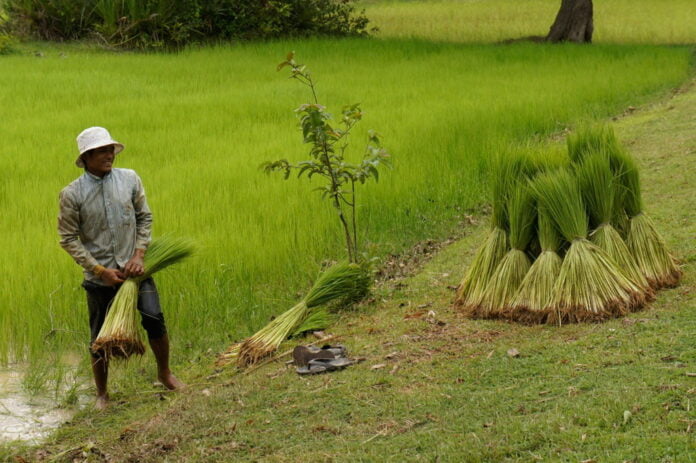The population of Siem Reap Province is around 1million, and is growing at approximately 2.5% per year. Spanning an area of land of 10,299 square kilometres, the province has a population density of around 100 people per square kilometers. Out of the twelve districts in the province, the most populous by a large margin is central Siem Reap – accounting for 20% of the province’s population. Despite this, and even taking into account the tourist swell, which doubles and triples the population at different times of the year, Siem Reap still has a charming small-town feel. The hotels and restaurants are clustered in a small area, making the city center easy to navigate, easy to escape from, and leaving the rest of the province relatively untouched by the tourist masses.
Cambodia has a particularly homogenous population, with 95% of people ethnically Khmer, and the remaining 5% made of up of ethnic Vietnamese, Chinese and Cham. Siem Reap is typical in this way unlike the eastern provinces of Ratankiri and Mondulkiriwh ere indigenous tribal groups make up a larger percentage of the population. However, Siem Reap still feels relatively diverse, as the thriving city hosts expatriates from around the world working in the tourism and development industries. Initially, the dominant nationality of this group was French, due to the strong connection between the two countries from the days of the French protectorate. In fact, many Cambodians still refer to anyone who doesn’t look Asian as “barang” – which means “French” in Khmer – regardless of where they are from, as 100 years ago all the non-Asians in Cambodia were pretty much guaranteed to be French. However, now Cambodia is developing as a tourist destination and more working opportunities are available, the mix of expatriates is far greater.
In Cambodia, the tourist population is dominated by visitors from ASEAN nations, as well as South Korea, China and Japan. From outside Asia, the American, French and Australian visitors are the most common. This is reflected in the spectrum of visitors to Siem Reap. Siem Reap airport receives more tourists than Phnom Penh airport, and over 50% of all visitors to the country are heading to Siem Reap.
Demography of Siem Reap
Due to the Khmer Rouge regime and the ensuring civil war, nearly a whole generation of people in Cambodia lost their lives. The ensuing population boom in peace time means that the majority of the population is under 30 years old. As of 2010, 34% of population of Siem Reap was under 17. There are very few “old” people in Cambodia – only 5% of the population in Siem Reap is over 61 years of age – the average life expectancy only being 63 years of age (still nearly double what it was 35 years ago). The balance between male and female is almost equal. 51% of the people living in Siem Reap province are female and 49% are male.Women live in general longer and their life expectancy is almost 66 years old, while for men it’s only 61 years old.
Income
The low life expectancy in Cambodia compared to neighboring Thailand and Vietnam demonstrates the difference in prosperity in Cambodia in relation to its neighbors. Strikingly, despite the huge numbers of tourists visiting Siem Reap, the province still remains one of the poorest in the country. According to World Bank research, 45% of the population under the poverty line, which, for rural areas is approximately 3,200 riel per day – roughly equivalent to $0.75USD. While there are many opportunities within the service industry in the city of Siem Reap, travel just a few kilometers outside and the potential to earn a living wage decreases dramatically. As of 2010, only 20% of housing in Siem Reap was on the electricity grid and 35% of houses still did not have access to safe drinking water. A child growing up just 1 hour outside of Siem Reap city (still within Siem Reap province) is twice as likely to drop out of school as a child growing up within the city area.
Migration
Many families in Siem Reap who are struggling to survive unsurprisingly look for a solution outside their own community. However, this solution is not found in the tourist dollars of Siem Reap, but instead through illegal migration to Thailand for seasonal labor – generally in the construction industry. While the process of migration can be dangerous, and working illegally leaves people vulnerable to exploitation, many people are willing to take the risk in order to make the $5 a day that is on offer across the border. This is substantially more than many people can hope to make in a day in rural Cambodia and even in unskilled jobs in the city. Starting salaries in hotels and restaurants don’t pay much more than this (some pay less) and if employers require a completed high school education then most rural students won’t even bother to apply.
Culture and customs
Due to the social and economic diversity of the population of Siem Reap province, it is possible to have very different experiences of Cambodian life and the attitude of Cambodian people. Many visitors who make brief stops in Siem Reap can feel hassled by tuk tuk drivers, and uncomfortable around the persistent street children. Without taking the time to stop and have a chat it can be easy to feel that the population exists for the pockets of the tourists. In fact, in Cambodia, hospitality is ingrained into the culture. It is customary to always ask a visitor if they have eaten, and to share food if they have not. Many Cambodian people are very keen to share their food, language, culture and customs with visitors, as they are well aware that it is not exported across the globe in the same way as in other countries, and so the majority of visitors will never experience it outside of Cambodia. Cambodian’s are intensely proud of their country and their heritage – and there is a push to keep alive many of the old traditions that were very nearly wiped out during the Khmer Rouge. Any visitors who have the good fortune to be invited to a family home for a visit, for food, or maybe even a wedding should make the most of the opportunity and are likely to be treated as the guest of honor.



